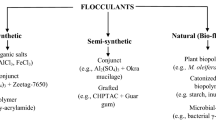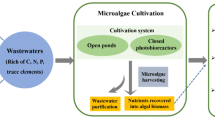Abstract
The present work aims to evaluate the potential for bioremediation and CO2 fixation by cultivating the microalgae of the genus Chlorella minutissima in cassava wastewater. Experimental work investigated the growth of microalgae in the effluent and determined its growth rate based on different dilutions. Four culture media scenarios were created. The values measured in the laboratory were compared with a mathematical model adjusted based on the kinetic growth. The efficiency of the process was evaluated in terms of the reduction of the organic load, nutrient consumption, and cell count in the initial state (time 0) and complete growth (after the seventh day) using microscopy analysis. After biological treatment, a percentage of reduction of COD (chemical oxygen demand) of around 30%, TS (total solids) 75%, nutrient removal 92%, cyanide near 99%, and average CO2 biofixation 0.19 g L−1 d−1 were observed. The reduction percentages are close to those found in the literature for other cultivation media. It was observed in this study that the biomass productivity and CO2 fixation agree with those obtained in other studies and confirm the efficiency of the very tiny Chlorella microalgae with high photosynthetic capacity.






Similar content being viewed by others
Abbreviations
- CO2 :
-
Carbon dioxide
- COD:
-
Chemical oxygen demand
- BOD:
-
Biochemical oxygen demand
- As + 5:
-
Arsenic
- N:
-
Nitrate
- P:
-
Phosphate
- W:
-
Watts
- TS:
-
Total solids
- STF:
-
Total fixed solids
- TVS:
-
Total volatile solids
- SS:
-
Sedimentable solids
- TOC:
-
Total organic carbon
- ANOVA:
-
Analysis of variance
- CONAMA:
-
National Environment Council
- INEA-RJ:
-
State Environment Institute-RJ
References
APHA (American Public Health Association). . (2005). Standard methods for the examination for water and wastewater (19th ed.). Byrd Press.
Arbib, Z., Ruiz, J., Álvarez-Díaz, P., Garrido-Pérez, C., & Perales, J. A. (2014). Capability of different microalgae species for phytoremediation processes: Wastewater tertiary treatment, CO2 bio-fixation and low-cost biofuels production. Water Research, 49, 465–474.
Ashwaniy, V. R., & Perumalsamy, M. (2017). Reduction of organic compounds in petrochemical industry effluent and desalination using Scenedesmus abundant algal microbial desalination cell. Journal of Environmental and Chemistry., 5, 5961–5967.
Barana, A. C., & Cereda, M. P. (2000). Cassava wastewater (Manipueira) treatment using a twophase anaerobic biodigestor. Ciência. e Tecnologia. De Alimentos, 20, 1–9.
Bertoldi, F., & Ernani Sant’Anna, E & Oliveira, J.L.B. . (2008). Chlorophyll content and minerals profile in the microalgae Chlorella vulgaris cultivated in hydroponic wastewater. Ciencia Rural, 38, 54–58.
Cabanelas, I. T. D., Arbib, Z., Chinalia, F. A., Souza, C. O., Perales, J. A., Almeida, P. F., et al. (2013). From waste to energy: Microalgae production in wastewater and glycerol. Applied Energy, 109, 283–290.
Camara, M., Jamil, N. R., & Abdullah, A. F. B. (2019). Impact of land uses on water quality in Malaysia: A review. Ecological Processes, 8, 10.
Chavalparit, O., & Ongwandee, M. (2009). Clean technology for the tapioca starch industry in Thailand. Journal of Cleaner Production, 17, 105–110.
Chen, H., Wang, J., Zheng, Y., Zhan, J., He, C., & Wang, Q. (2018). Algal biofuel production coupled bioremediation of biomass power plant wastes based on Chlorella sp. C2 cultivation. Applied Energy., 211, 296–305.
Costa, J. A. V., Linde, G. A., Atala, D. I. P., Mibielli, G. M., & KruEger, R. T. (2000). Modelling of growth conditions for cyanobacterium Spirulina platensis in microcosms. World Journal of Microbiology & Biotechnology, 16, 15–18.
Diniz, G. S., Silva, A. F., Araújo, O. Q. F., & Chaloub, R. M. (2017). The potential of microalgal biomass production for biotechnological purposes using wastewater resources. Journal of Applied Phycology, 29, 821–832.
Dunoyer, A. T., Cuello, R. E. C., & Salinas, R. P. (2020). Biodegradation of a dairy waste using Yarrowia lipolytica ATCC 9773. Revista Ambiente & Água, 15, 2448. https://doi.org/10.4136/ambi-agua.2448.
Evers, E. G. (1991). A model for light-limited continuous cultures: Growth, shading, and maintenance. Biotechnology and Bioengineering, 38, 254–259.
Fernández, F. G. A., Garcia Camacho, F., Pérez, J. A. S., Fernández Sevilha, J., & Grima, E. M. (1998). A model for light distribution and average solar irradiance inside outdoor tubular photobioreactors for microalgal mass culture. Effects of dilution rate, tube diameter and solar irradiance. Biotechnology and Bioengineering, 58, 605–611.
Ferreira, A., Marques, P., Ribeiro, B., Asseamany, P., De Mendonça, H. V., Barata, A., et al. (2018). Combining biotechnology with circular bioeconomy: From poultry, swine, cattle, brewery, dairy and urban wastewaters to biohydrogen. Environmental Research, 164, 32–38.
Goldman, J. C., & Ryther, J. H. (1976). Temperature-influenced species competition in mass cultures of marine phytoplankton. Biotechnology and Bioengineering., 18, 1125–1144.
Gonçalves, A. L., Simões, M., & Pires, J. C. M. (2014). The effect of light supply on microalgal growth, CO2 uptake and nutrient removal from wastewater. Energy Conversion and Management, 85, 530–536.
Grima, E. M., Camacho, F. G., Pérez, J. A. S., Sevilla, J. M. F., Fernandez, F. G., & Contreras Gomez, A. (1994). A mathematical model of microalgal growth in light–limited chemostat culture. Journal of Chemical Technology and Biotechnology, 61, 167–173.
Haritash, A. K., Dutta, S., & Sharma, A. (2017). Phosphate uptake and translocation in a tropical Canna-based constructed wetland. Ecological Processes, 6, 12.
Kee, M., et al. (2017). Cultivation of Chlorella vulgaris using nutrients source from domestic wastewater for biodiesel production: Growth condition and kinetic studies. Renewable Energy, 103, 197–207.
Lam, M. K., & Lee, K. T. (2013). Effect of carbon source towards the growth of Chlorella vulgaris for CO2 bio-mitigation and biodiesel production. Internaional Jpurnal of Green Gas and Control Medicine, 14, 169–176.
Liu, G., Liao, Y., Wu, Y., Ma, X., & Chen, L. (2017). Characteristics of microalgae gasification through chemical looping in the presence of steam. International Journal of Hydrogen Energy, 42, 22730–22742. https://doi.org/10.1016/j.ijhydene.2017.07.173.
MEJ (Ministry of the Environment – Government of Japan). (1974). - Launch standards of effluents -363/1974.
Mofijur, M., Rasul, M. G., Hyde, J., Azad, A. K., Mamat, R., & Bhuiya, M. M. K. (2016). Role of biofuel and their binary (diesel–biodiesel) and ternary (ethanol–biodiesel–diesel) bends on internal combustion engines emission reduction. Renewable and Sustainable Energy Reviews, 53, 265–278.
Mohammadi, M., Mowla, D., Esmaeilzadeh, F., & Ghasemi, Y. (2018). Cultivation of microalgae in a power plant wastewater for sulfate removal and biomass production: A batch study. Journal of Environmental Chemistry, 6, 2812–2820.
Mohd Udaiyppan, A. F., Hasan, H. A., Takriff, M. S., Abdullah, R. S., Maeda, T., Mustapha, N. A., Yasin, N. H. M., & Hakimi, N. I. N. M. (2020). Microalgae-bacteria interaction in palm oil mill effluent treatment. Journal of Water Process Engineering, 35, 101203. https://doi.org/10.1016/j.jwpe.2020.101203.
Mohd Yunos, F. H., Nasir, N. M., Wan Jusoh, H. H., Khatoon, H., Lam, S. S., & Jusoh, A. (2017). Harvesting of microalgae (Chlorella sp.) from aquaculture bioflocs using an environmental-friendly chitosan-based bio-coagulant. International Biodeterioration & Biodegradation, 124, 243–249.
Molazadeh, et al. (2019). Influence of CO2 concentration and N: P ratio on Chlorella vulgaris-assisted nutrient bioremediation, CO2 biofixation and biomass production in a lagoon treatment plant. Journal of the Taiwan Institute of Chemical Engineers., 96, 114–120.
Mujtaba, G., & Lee, K. (2017). Treatment of real wastewater using co-culture of immobilized Chlorella vulgaris and suspended activated sludge. Water Research., 120, 174–184.
Nascimento, I. A., Cabanelas, I. T. D., Santos, J. N., Nascimento, M. A., Sousa, L., & Sansone, G. (2015). Biodiesel yields and fuel quality as criteria for algal-feedstock selection: Effects of CO2-supplementation and nutrient levels in cultures. Algal Research, 8, 53–60.
NEC (National Environment Council). (2008). Effluent release patterns. Resolution 397/2008.
Oliveira, D. A., Mezzomo, N., Gomes, C., & Ferreira, S. R. S. (2017a). Encapsulation of passion fruit seed oil by means of supercritical antisolovent process. The Journal of Supercritical Fluids., 129, 96–105.
Oliveira, O., Giansella, S., Silva, V., Mata, T., & Caetano, N. S. (2017b). Lipid and carbohydrate profile of a microalgae isolated from mastemater. Energy Procedia., 136, 468–473.
PEC (Parliaments and European Council). (1991). Water framework directive. Directive 91/271 / ECC.
Pérez, B. E., Pina, C. I., & Rodriguez, L. P. (2008). Kinetic model for growth of Phaeodactylum tricornutum in intensive culture photobioreactor. Biochemical Engineering Journal., 40, 520–525.
Pohndorf, R. S., Camara, A. S., Larrosa, A. P. Q., Pinheiro, C. P., Strieder, M. M., & Pinto, L. A. A. (2016). Production of lipids from microalgae Spirulina sp.: Influence of drying, cell disruption and extraction methods. Biomass and Bioenergy., 93, 25–32.
Rammirez, J. A., Meraz, M., & Vermon-Carter, E. J. (2019). A theoretical derivation of the monod equation with a kinetics sense. Biochemical Engineering Journal, 150, 15015. https://doi.org/10.1016/j.bej.2019.107305.
Roels, J. A. (1983). Energetics and kinetics in biotechnology. Elsevier.
Samorì, G., Samorì, C., Guerrini, F., & Pistocchi, R. (2013). Growth and nitrogen removal capacity of Desmodesmus communis and of a natural microalgae consortium in a batch culture system in view of urban wastewater treatment: Part I. Water Research, 47, 791–801.
Santana, H., Cereijo, C. R., Teles, V. C., Nascimento, R. C., Fernandes, M. S., Brunale, P., et al. (2017). Microalgae cultivation in sugarcane vinasse: Selection, growth and biochemical characterization. Bioresource Technology, 228, 133–140.
SEI (State environment institute – RJ) (1986) Technical Note 202/R-10. Criteria and standards for launching fluid fluids.
Tagliaferro, G. V., Izário Filho, H. J., Chandel, A. K., Silva, S. S., Silva, M. B., & Santos, J. C. (2019). Continuous cultivation of Chlorella minutissima 26a landfill leachate-based medium using concentric tube airlift photobioreactor. Algal Research, 41, 101549. https://doi.org/10.1016/j.algal.2019.101549.
USEPA (United States Environmental Protection Agency). (2013). Technical support document: Cost estimate of phosphorus removal at wastewater treatment plants.
Yang, J., Rasa, E., Tantayotai, P., Scow, K. M., Yuan, H., & Hristova, K. R. (2016). Mathematical model of Chlorella minutissima UTEX2341 growth and lipid production under photoheterotrophic fermentation conditions. Bioresource Technology, Medicine, 102, 3077–3082.
Zhang, M., Xie, L., Yin, Z., Khanal, S. K., & Zhou, Q. (2016). Biorefinery approach for cassava-based industrial wastes: Current status and opportunities. Bioresource Technology, 215, 50–62.
Zhao, Y., Chen, J. C., Shen, Y., Wang, L., & Xu, X. M. (2014). Microalgal culture for CO2 fixation and manure wastewater treatment. Chinese Jounal of Environmental Engineering, 8, 3353–3358.
Zheng, Z., Xu, Y., Wang, J., Li, Y., & Gu, B. (2019). Environmental stress and eutrophication in freshwater wetlands: evidence from carbon and nitrogen stable isotopes in cattail (Typha domingensis Pers.). Ecological Processes, 8, 31. https://doi.org/10.1186/s13717-019-0186-4.
Acknowledgements
The authors thank the Metallurgical Engineering graduate program of the Fluminense Federal University for the scientific-technical support.
Author information
Authors and Affiliations
Corresponding author
Additional information
Publisher’s Note
Springer Nature remains neutral with regard to jurisdictional claims in published maps and institutional affiliations.
Rights and permissions
About this article
Cite this article
de Faria Ferreira Carraro, C., Loures, C.C.A. & de Castro, J.A. Microalgae Technique for Bioremediation Treatment of Cassava Wastewater. Water Air Soil Pollut 232, 281 (2021). https://doi.org/10.1007/s11270-021-05199-9
Received:
Accepted:
Published:
DOI: https://doi.org/10.1007/s11270-021-05199-9




